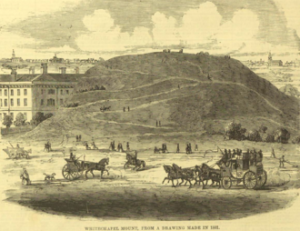
London Signs and Inscriptions, 1897
The mysterious mount had a storied history that by the end of the Georgian era made it a popular place for human and dog fights. The image was dated 1801 and shows how it would have been in the Regency era, before it was levelled around 1808 (Bard, 2014). There are disputes about what year it was actually levelled, the excerpt below claiming 1805 and another source stating 1807.
Adjacent to the London Hospital on Whitechapel Road, was also known as Mount-row and one time served as a laystall (Cooke, 1833). When it was levelled, numerous artifacts were found amongst the soil including an old pub sign, a silver tankard and a roman coin and attracted a raft of treasure seekers. There are two primary rumours that circulated about the Mount without ever being proven. The first was that it was the burial site for victims of the Great Plague. The second, and most popular (and probably accepted as truth during the Regency era) was that it was where rubble from the Great Fire of London (1666) was placed.
It was levelled to make way for new roads (Mount Place, Mount Terrace and Mount Street) to access the East and West India Docks. The soil was purportedly repurposed to make bricks, some which were used in buildings that still stand today like the Black Eagle Brewery.
Bard, R. (2014). Whitechapel & Stepney Through Time. United Kingdom: Amberley Publishing.
Cooke, G. A. (1833). Walks Through London: Or, A Picture of the British Metropolis : Containing Architectural Descriptions of the Buildings of the Cities of London and Westminster, the Borough of Southwark, and Their Environs …. United Kingdom: Sherwood, Gilbert and Piper.











